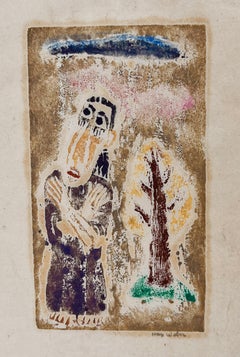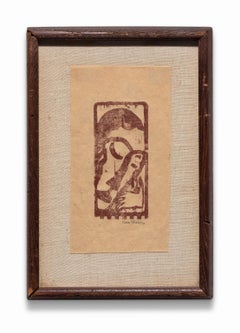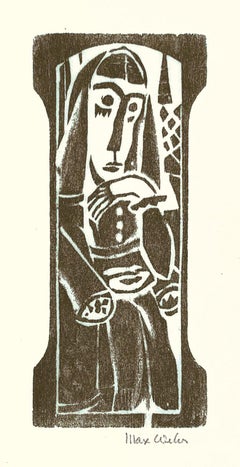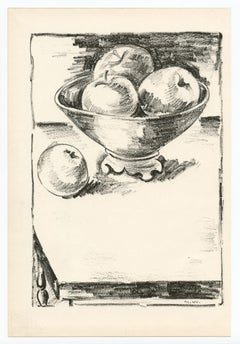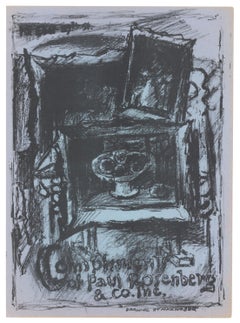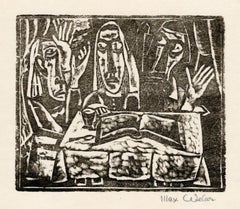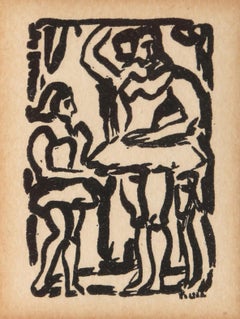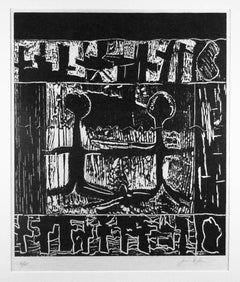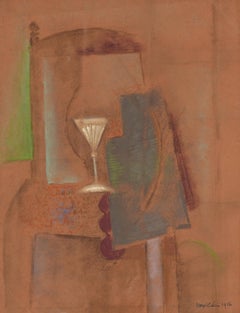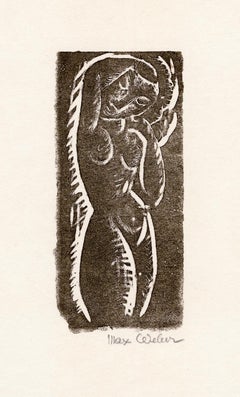Max Weber Art
to
9
2
1
Overall Width
to
Overall Height
to
12
1
2
4
1
1
1
4
1
9
3
5
4
3
2
2
1
1
1
6
2
2
1
1
12
8,228
2,805
1,654
1,315
1
12
Artist: Max Weber
Invocation
By Max Weber
Located in New York, NY
M a x W e b e r – – 1 8 8 1 – 1 9 6 1
Invocation- – 1919-20, Color Woodcut.
Rubenstein 27. Proofs only. Signed in pencil.
Image size 3 3/4 x 2 1/8 inches (124 x 54 mm); sheet size ...
Category
1910s Cubist Max Weber Art
Materials
Woodcut
$13,500
Max Weber Woodcut Print from "Primitives" Poetry Book Signed
By Max Weber
Located in Detroit, MI
ONE WEEK ONLY SALE
This woodcut print is an expressionist print on one of the poems from Max Weber's poetry collection "Primitives: Poems and Woodcuts". This work is signed in penci...
Category
1920s Expressionist Max Weber Art
Materials
Woodcut
'Seated Figure' — American Expressionism
By Max Weber
Located in Myrtle Beach, SC
Max Weber, 'Seated Figure", woodcut, edition not stated, 1919-20, Rubenstein 17. Signed in pencil. A fine impression on cream Japan paper; the full sheet with margins (2 to 3 1/8 in...
Category
1920s Expressionist Max Weber Art
Materials
Woodcut
"Still Life" original lithograph
By Max Weber
Located in Henderson, NV
Medium: original lithograph. Printed in 1930 in an edition of 250 and published in New York by The Downtown Gallery. Size: 10 x 6 3/4 inches (252 x 172 mm). Signed in the plate; not ...
Category
1930s Max Weber Art
Materials
Lithograph
original lithograph
By Max Weber
Located in Henderson, NV
Medium: original lithograph. This lithograph is from the rare 1951 "Improvisations" portfolio, published by the Artists Equity Association of New York on the occasion of the 1951 Spr...
Category
1950s Max Weber Art
Materials
Lithograph
'Feast of Passover' — American Expressionism
By Max Weber
Located in Myrtle Beach, SC
Max Weber, Untitled 'Feast of Passover', woodcut, 1920, edition proofs—this impression from the edition of 25 printed in 1956, Rubenstein 30. Signed in pencil...
Category
1920s Expressionist Max Weber Art
Materials
Woodcut
Spring - American Cubism
By Max Weber
Located in Miami, FL
Cubist influence mixed with soft warm colors is on full display in this charming work.
Signed twice.
6 Gallery Tags on verso
Sotheby's
Kennedy Galleries
Barbara Mathes Gallery
Sid Deutsch Gallery
The Downtown Gallery
University of Arizona Art...
Category
1910s Cubist Max Weber Art
Materials
Pastel
Mother Love (Madonna and Child) — American Expressionism
By Max Weber
Located in Myrtle Beach, SC
Max Weber, 'Mother Love' (Madonna and Child), woodcut, 1920, edition not stated, Rubenstein 35. Signed in pencil. A fine impression, on cream wove Japan paper, with full margins (1 5...
Category
1920s Expressionist Max Weber Art
Materials
Woodcut
Nude on Chair
By Max Weber
Located in Miami, FL
Heavy impasto pained in alla prima ( Wet-on-wet ) technique. Layer of damar varnish. Frame burn, On Masonite. Unframed
Signature: Signed Max Weber upper left.
Category
1940s Cubist Max Weber Art
Materials
Oil
American Modernist Cubist Lithograph Screenprint "Reclining Woman" Max Weber
By Max Weber
Located in Surfside, FL
Reclining Cubist Nude Woman
Max Weber (April 18, 1881 – October 4, 1961) was a Jewish-American painter and one of the first American Cubist painters who, in later life, turned to more figurative Jewish themes in his art. He is best known today for Chinese Restaurant (1915), in the collection of the Whitney Museum of American Art, "the finest canvas of his Cubist phase," in the words of art historian Avis Berman.
Born in the Polish city of Białystok, then part of the Russian Empire, Weber emigrated to the United States and settled in Brooklyn with his Orthodox Jewish parents at the age of ten. He studied art at the Pratt Institute in Brooklyn under Arthur Wesley Dow. Dow was a fortunate early influence on Weber as he was an "enlightened and vital teacher" in a time of conservative art instruction, a man who was interested in new approaches to creating art. Dow had met Paul Gauguin in Pont-Aven, was a devoted student of Japanese art, and defended the advanced modernist painting and sculpture he saw at the Armory Show in New York in 1913.
In 1905, after teaching in Virginia and Minnesota, Weber had saved enough money to travel to Europe, where he studied at the Académie Julian in Paris and acquainted himself with the work of such modernists as Henri Rousseau (who became a good friend), Henri Matisse, Pablo Picasso, and other members of the School of Paris. His friends among fellow Americans included some equally adventurous young painters, such as Abraham Walkowitz, H. Lyman Sayen, and Patrick Henry Bruce. Avant-garde France in the years immediately before World War I was fertile and welcoming territory for Weber, then in his early twenties. He arrived in Paris in time to see a major Cézanne exhibition, meet the poet Guillaume Apollinaire, frequent Gertrude Stein's salon, and enroll in classes in Matisse's private "Academie." Rousseau gave him some of his works; others, Weber purchased. He was responsible for Rousseau's first exhibition in the United States.
In 1909 he returned to New York and helped to introduce Cubism to America. He is now considered one of the most significant early American Cubists, but the reception his work received in New York at the time was profoundly discouraging. Critical response to his paintings in a 1911 show at the 291 gallery, run by Alfred Stieglitz, was an occasion for "one of the most merciless critical whippings that any artist has received in America." The reviews were "of an almost hysterical violence." He was attacked for his "brutal, vulgar, and unnecessary art license." Even a critic who usually tried to be sympathetic to new art, James Gibbons Huneker, protested that the artist's clever technique had left viewers with no real picture and made use of the adage, "The operation was successful, but the patient died."[8] As art historian Sam Hunter wrote, "Weber's wistful, tentative Cubism provided the philistine press with their first solid target prior to the Armory Show."
The Cellist...
Category
Mid-20th Century Cubist Max Weber Art
Materials
Screen
Max Weber, Figure
By Max Weber
Located in New York, NY
One of America's great modernist innovators, Max Weber carved Figure, 1919-20, on the end piece of a wooden cigar box. This Cubist image is composed o...
Category
Early 20th Century Modern Max Weber Art
Materials
Woodcut
Summer, 1910
By Max Weber
Located in Miami, FL
Complex study of nude figures grouping in landscape. Weber works in watercolor and pen with an electric brushstroke. Perhaps a study or a continuation for his major oil. Summer...
Category
Early 1900s Cubist Max Weber Art
Materials
Ink, Watercolor
$48,000
Related Items
Dancers, 1936 Woodcut by Georges Rouault
By Georges Rouault
Located in Long Island City, NY
Dancers
Georges Rouault, French (1871–1958)
Date: 1936
Woodcut, initialed in the stone
Size: 3 x 2 in. (7.62 x 5.08 cm)
Frame Size: 9.5 x 8.25 inches
Category
1930s Expressionist Max Weber Art
Materials
Woodcut
Dancing in the Dark
By Joan Snyder
Located in New York, NY
Joan Snyder has been called an autobiographical, even confessional artist, who draws from her experiences and surroundings to create her paintings. While her subjects vary widely, Sn...
Category
1980s Expressionist Max Weber Art
Materials
Woodcut
SITZENDER HARLEKIN
By Heinrich Campendonk
Located in Portland, ME
Campendonk, Heinrich. SITZENDER HARLEKIN. Engels/Sohn 59. Woodcut, 1922. 15 x 11 3/8 inches; 380 x 290 mm. Signed in pencil. In Excellent condition. Framed.
Category
20th Century Expressionist Max Weber Art
Materials
Woodcut
'Plowing It Under' — WPA Era American Regionalism
By Thomas Hart Benton
Located in Myrtle Beach, SC
Thomas Hart Benton, 'Goin' Home', lithograph, 1937, edition 250, Fath 14. Signed in pencil. Signed in the stone, lower right. A fine, richly-inked impression, on off-white, wove pape...
Category
1930s American Realist Max Weber Art
Materials
Lithograph
Picasso, Composition (J/Vollard 193; Monod 10485), Hélène chez Archimède (after)
By Pablo Picasso
Located in Auburn Hills, MI
Woodcut on vélin de Montval-Maillol paper. Paper Size: 17.3 x 12.6 inches; image size: 9.1 x 5.5 inches. Inscription: Unsigned and unnumbered, as issued. Catalogue raisonné reference...
Category
1950s Cubist Max Weber Art
Materials
Woodcut
$1,116 Sale Price
20% Off
H 17.3 in W 12.6 in
"Schwartzer Fleck" original woodcut
By Wassily Kandinsky
Located in Henderson, NV
Medium: original woodcut. Catalogue reference Roethel 145. Printed in Paris in 1938 for the art revue XXe Siecle (issue number 3). Image size: 7 x 8 1/2 inches (170 x 218 mm). Sheet ...
Category
1930s Expressionist Max Weber Art
Materials
Woodcut
Variation 4, Vol. I
By Katherine Sophie Dreier
Located in Myrtle Beach, SC
Katherine S. Dreier, 'Variation 4, Vol. I' from '1 to 40 Variations', lithograph with pochoir and hand-coloring, 1934, edition 65. Stenciled signature and date, lower right. Annotate...
Category
Mid-20th Century American Modern Max Weber Art
Materials
Watercolor, Lithograph, Stencil
Picasso, Femme Accoudee au Fauteuil (after)
By Pablo Picasso
Located in Fairfield, CT
Artist: Pablo Picasso (1881-1973)
Title: Femme Accoudee au Fauteuil
Year: 1982
Medium: Lithograph on Arches paper
Size: 28.5 x 21.5 inches
Edition: 1000, plus proofs
Condition: Good
...
Category
1980s Cubist Max Weber Art
Materials
Lithograph
Picasso, Femme Assise a la Robe Bleu (after)
By Pablo Picasso
Located in Fairfield, CT
Artist: Pablo Picasso (1881-1973)
Title: Femme Assise a la Robe Bleu
Year: 1981
Medium: Lithograph on Arches paper
Size: 29 x 22 inches
Edition: 1000, plus proofs
Condition: Good
Ins...
Category
1980s Cubist Max Weber Art
Materials
Lithograph
Picasso, La Couple (after)
By Pablo Picasso
Located in Fairfield, CT
Artist: Pablo Picasso (1881-1973)
Title: La Couple
Year: 1982
Medium: Lithograph on Arches paper
Size: 30 x 21.75 inches
Edition: 1000, plus proofs
Condition: Good
Inscription: Signe...
Category
1980s Cubist Max Weber Art
Materials
Lithograph
Picasso, Nature Morte au Pichet Rose (after)
By Pablo Picasso
Located in Fairfield, CT
Artist: Pablo Picasso (1881-1973)
Title: Nature Morte au Pichet Rose
Year: 1979
Medium: Lithograph on Arches paper
Size: 21.25 x 28.25 inches
Edition: 224/500;500, plus proofs
Condit...
Category
1970s Cubist Max Weber Art
Materials
Lithograph
'Girl with Hands to Face' — Mid-century Modernism
By Benton Murdoch Spruance
Located in Myrtle Beach, SC
Benton Spruance, 'Girl with Hands to Face', two-color lithograph, 1940, edition 30, Fine and Looney 180. Signed, titled, and annotated 'Ed. 30' in pencil. A superb impression, on cr...
Category
1940s American Modern Max Weber Art
Materials
Lithograph
$960 Sale Price
20% Off
H 15.94 in W 10 in
Previously Available Items
The Cocktail
By Max Weber
Located in Greenwich, CT
Max Weber was a Russian-born Jewish-American painter best known for introducing Cubism to the United States. Weber’s abstracted depictions of interiors, landscapes, and portraits, we...
Category
1910s Abstract Max Weber Art
Materials
Paper, Pastel
Nude Woman with Arm Upraised — American Expressionism
By Max Weber
Located in Myrtle Beach, SC
Max Weber, 'Nude Woman with Arm Upraised', linoleum cut, 1930-32, edition proofs—this impression from the edition of 25 printed in 1956, Rubenstein 42. Signed in pencil. A fine impression, on cream Japan paper; the full sheet with wide margins (2 5/8 to 3 7/8 inches), in excellent condition. Image size 5 7/8 x 2 11/16 inches (149 x 68 mm); sheet size 12 1/2 x 9 inches (318 x 229 mm). Matted to museum standards, unframed. Scarce.
Printed, at the artist’s request, by Joseph Blumenthal, The Spiral Press, New York. Included in the suite 'FIVE PRINTS BY MAX WEBER' published by Erhard Weyhe, director, Weyhe Gallery Inc., the renowned New York gallery established in 1919 to specialize in fine prints.
Collections: Detroit Institute of Arts, Library of Congress, National Gallery of Art, Los Angeles County Museum of Art, Philadelphia Museum of Art.
ABOUT THE ARTIST
"To fill eternity with the ripest and the sanest expression of our consciousness is the essence as well as the purpose of life.” —Max Weber
Max Weber (1881-1961) was born in Bialystok, western Russia. When he was ten, his family came to America, settling in Brooklyn. While enrolled at nearby Pratt Institute from 1898 to 1900, he was a student of the modernist artist and influential teacher Arthur Wesley Dow who advocated for art as a means of self-expression rather than traditional ornament.
Weber became an art teacher, first in the public schools in Lynchburg, Virginia, and beginning in 1903 at the Minnesota Normal School in Duluth. Inspired by Dow’s experience, Weber longed to continue his studies in Europe, and after years of prudent saving, he traveled to Paris in 1905.
He became a devoted disciple of Paul Cézanne, met Guillaume Apollinaire, Robert Delaunay, Pablo Picasso, and Leo and Gertrude Stein, and became close friends with Henri Rousseau, later organizing the first exhibition of Rousseau’s work in the United States. A pupil of Matisse...
Category
1920s Expressionist Max Weber Art
Materials
Woodcut
Primitive Figure — American Expressionism
By Max Weber
Located in Myrtle Beach, SC
Max Weber, Untitled 'Primitive Figure', woodcut, 1921-25, edition proofs—this impression from the edition of 25 printed in 1956, Rubenstein 40. Signed in pencil. A fine impression, on cream Japan paper; the full sheet with wide margins (1 1/8 to 3 inches), in excellent condition. This work features prominently in the artist's woodcut oeuvre in its relatively large scale: image size 9 15/16 x 3 1/16 inches (252 x 78 mm); sheet size 12 1/2 x 9 inches (318 x 229 mm). Scarce. Matted to museum standards, unframed.
Printed, at the artist’s request, by Joseph Blumenthal, The Spiral Press, New York. Included in the suite 'FIVE PRINTS BY MAX WEBER' published by Erhard Weyhe, director, Weyhe Gallery Inc., the renowned New York gallery established in 1919 to specialize in fine prints.
Collections: Art Institute of Chicago, Detroit Institute of Arts, National Gallery of Art, Museum of Modern Art, Philadelphia Museum of Art, Los Angeles County Museum of Art, Whitney Museum of American Art.
ABOUT MAX WEBER'S RELIEF PRINTS
"In summary, Weber’s relief prints cannot be called just primitives or cubist forms. No single stylistic term is a satisfactory label. Collectively they suggest some common denominators: independence from academic traditions, interest in the element of design rather optical realism, simplicity and unpretentiousness in execution, craftlike tradition underlying their formulation and the desire to eschew the exactitude and dryness of wood engraving for the imprecision and painterly of hand-blocked work. The work was not a conscious effort at naiveté or lack of sophistication; on the contrary it was an attempt to approach the origins of art.
"In an age which has seen the machine take the feeling of material from the hands of man, these relief prints describe a spirit of craftsmanship and an originality of abstract design that is unique to Max Weber’s artistic oeuvre, to American art, and to the tradition of relief printing."
— Daryl R. Rubenstein, 'Max Weber, A Catalogue Raisonné of His Graphic Work', The University of Chicago Press, 1980.
ABOUT THE ARTIST
"To fill eternity with the ripest and the sanest expression of our consciousness is the essence as well as the purpose of life.” —Max Weber
Max Weber (1881-1961) was born in Bialystok, western Russia. When he was ten, his family came to America, settling in Brooklyn. While enrolled at nearby Pratt Institute from 1898 to 1900, he was a student of the modernist artist and influential teacher Arthur Wesley Dow who advocated for art as a means of self-expression rather than traditional ornament.
Weber became an art teacher, first in the public schools in Lynchburg, Virginia, and beginning in 1903 at the Minnesota Normal School in Duluth. Inspired by Dow’s experience, Weber longed to continue his studies in Europe, and after years of prudent saving, he traveled to Paris in 1905.
He became a devoted disciple of Paul Cézanne, met Guillaume Apollinaire, Robert Delaunay, Pablo Picasso, and Leo and Gertrude Stein, and became close friends with Henri Rousseau, later organizing the first exhibition of Rousseau’s work in the United States. A pupil of Matisse...
Category
1920s Expressionist Max Weber Art
Materials
Woodcut
Nude with Upraised Arms
By Max Weber
Located in Fairlawn, OH
Nude with Upraised Arms
Honeycomb-basswood relief print, 1919-1920
Unsigned as usual for this edition
From: Woodcuts and Linoleum Blocks by Max Weber (32 plates)
Unsigned individual ...
Category
1910s Cubist Max Weber Art
Materials
Woodcut
American Modernist Cubist Color Screenprint - "Reclining Woman" Max Weber
By Max Weber
Located in Surfside, FL
Max Weber (April 18, 1881 – October 4, 1961) was a Jewish-American painter and one of the first American Cubist painters who, in later life, turned to more figurative Jewish themes in his art. He is best known today for Chinese Restaurant (1915), in the collection of the Whitney Museum of American Art, "the finest canvas of his Cubist phase," in the words of art historian Avis Berman.
Born in the Polish city of Białystok, then part of the Russian Empire, Weber emigrated to the United States and settled in Brooklyn with his Orthodox Jewish parents at the age of ten. He studied art at the Pratt Institute in Brooklyn under Arthur Wesley Dow. Dow was a fortunate early influence on Weber as he was an "enlightened and vital teacher" in a time of conservative art instruction, a man who was interested in new approaches to creating art. Dow had met Paul Gauguin in Pont-Aven, was a devoted student of Japanese art, and defended the advanced modernist painting and sculpture he saw at the Armory Show in New York in 1913.
In 1905, after teaching in Virginia and Minnesota, Weber had saved enough money to travel to Europe, where he studied at the Académie Julian in Paris and acquainted himself with the work of such modernists as Henri Rousseau (who became a good friend), Henri Matisse, Pablo Picasso, and other members of the School of Paris. His friends among fellow Americans included some equally adventurous young painters, such as Abraham Walkowitz, H. Lyman Sayen, and Patrick Henry Bruce...
Category
Mid-20th Century Cubist Max Weber Art
Materials
Screen
H 18.13 in W 24.25 in
Dancing Nudes
By Max Weber
Located in Fairlawn, OH
From: Woodcuts and Linoleum Blocks by Max Weber (32 plates)
Unsigned individual print(s),
The book signed in ink on the limitation page (a photocopy included with purchase)
Publishe...
Category
1910s Cubist Max Weber Art
Materials
Woodcut
Mother and Child
By Max Weber
Located in Fairlawn, OH
From: Woodcuts and Linoleum Blocks by Max Weber (32 plates)
Unsigned individual print(s),
The book signed in ink on the limitation page (a photocopy included with purchase)
Publisher: Weyhe Gallery, New York, 1956
Printer: The Spiral Press
Edition: 225
From: Woodcuts and Linoleum Blocks by Max Weber (32 plates)
Unsigned individual print(s),
The book signed in ink on the limitation page (a photocopy included with purchase)
Publisher: Weyhe Gallery, New York, 1956
Printer: The Spiral Press
Edition: 225
Note: Many of the images are influenced by Picasso, Matisse, Gauguin and other important European artists of the time. He was a friend and advocate of Henri Rousseau, along with Picasso. He exhibited at Stieglitz’s 291 Gallery. Weber’s work was admired and collected
by the famous photographers, Alvin Langdon...
Category
1910s American Modern Max Weber Art
Materials
Woodcut
Figure
By Max Weber
Located in Fairlawn, OH
Unsigned (as usual for this edition)
From: Woodcuts and Linoleum Blocks by Max Weber (32 plates)
Unsigned individual print(s),
The book signed in ink on the limitation page (a photocopy included with purchase)
Publisher: Weyhe Gallery, New York, 1956
Printer: The Spiral Press
Edition: 225
Heavily inspired by Picasso, his friend and mentor
Note: Many of the images are influenced by Picasso, Matisse, Gauguin and other important European artists of the time. He was a friend and advocate of Henri Rousseau, along with Picasso. He exhibited at Stieglitz’s 291 Gallery. Weber’s work was admired and collected
by the famous photographers, Alvin Langdon Coburn...
Category
1910s Cubist Max Weber Art
Materials
Woodcut
Primitives, Poems and Woodcuts.
By Max Weber
Located in New York, NY
WEBER, Max. Primitives, Poems and Woodcuts. [36] pp. Illustrated with 11 woodcuts by Weber. 8vo., bound in publisher's original decorated boards in a new gray cloth folding box, ...
Category
1920s Cubist Max Weber Art
Materials
Paper
Head
By Max Weber
Located in Myrtle Beach, SC
Max Weber, 'Head', woodcut, 1919-1920, edition unknown, Rubenstein 21. Signed in pencil. A fine impression, on cream wove Japan paper, with wide margins (1 1/2 to 2 1/2 inches); slig...
Category
Early 20th Century Expressionist Max Weber Art
Materials
Woodcut
Mother Love (Madonna and Child)
By Max Weber
Located in Myrtle Beach, SC
Max Weber, 'Mother Love' (Madonna and Child), woodcut, 1920, edition unknown, Rubenstein 35. Signed in pencil. A fine, well-inked impression, on cream wov...
Category
1920s Expressionist Max Weber Art
Materials
Woodcut
“Portrait of a Hasidic”
By Max Weber
Located in Southampton, NY
Watercolor and oil pastel on paper by the well known American artist, Max Weber. Circa 1945. Signed in pencil lower right. Condition: Excellent. Provenance: Hertz Gallery, Lawrenc...
Category
1940s American Modern Max Weber Art
Materials
Paper, Oil Pastel, Watercolor
Max Weber art for sale on 1stDibs.
Find a wide variety of authentic Max Weber art available for sale on 1stDibs. You can also browse by medium to find art by Max Weber in woodcut print, ink, paint and more. Much of the original work by this artist or collective was created during the 20th century and is mostly associated with the Expressionist style. Not every interior allows for large Max Weber art, so small editions measuring 2 inches across are available. Customers who are interested in this artist might also find the work of André Lhote, Léopold Survage, and Miette Braive. Max Weber art prices can differ depending upon medium, time period and other attributes. On 1stDibs, the price for these items starts at $150 and tops out at $215,000, while the average work can sell for $7,500.
